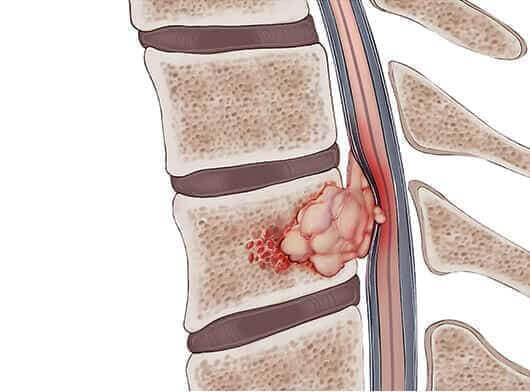A spinal tumour is an abnormal mass formed by the uncontrolled growth of the cells within the spinal cord or the spinal column, which may be non-cancerous (benign) or cancerous (malignant).
- Benign Tumours – Common benign tumours are
-
Meningioma:
It is a tumour that arises from the meninges — the membranes that surround the brain and spinal cord. They are very slow growing and occur more commonly in women. -
Neurofibroma:
It is a tumour that forms soft bumps on or under the skin. A neurofibroma can develop within a major or minor nerve anywhere in the body. It may, however, become malignant, but this is very rare. -
Schwannoma:
It is a type of nerve of the nerve sheath.
Generally, it grows slowly and is painless. They are rarely cancerous, but they can lead to nerves damage and loss of muscle control. -
Glioma:
It is a type of tumour that occurs in the brain and spinal cord. The type of glioma helps determine the treatment and prognosis.
Types of glioma include: - Astrocytomas: An astrocytoma is a brain tumour that affects a type of glial cell known as an astrocyte. The astrocytes provide various supportive functions in the central nervous system, including repair processes, the provision of nutrients and the regulation of electrical impulses in the brain. It is usually diagnosed only when it causes symptoms such as headaches, seizures, memory loss, nausea, blurred vision, or behavioural changes.
- Oligodendrogliomas: This forms from oligodendrocytes — cells in the brain and spinal cord that produce a substance that protects nerve cells. It can occur at any age but most often affects adults.
-
Ependymoma:
This begins in the ependymal cells in the brain and spinal cord that line the passageways where the fluid (cerebrospinal fluid) that nourishes the brain flows.
This tumour most often occurs in adults and may cause weakness in the part of the body controlled by the nerves that are affected by the tumour. In young children, it may present as headaches and seizures. - Malignant Tumours
-
Chordoma:
Chordoma is a rare type of bone cancer, and it may occur between the ages of 40 to 60.
It happens most often in the bones of the spine or the skull in adults though most often forms where the skull sits atop the spine (skull base) or at the bottom of the spine (sacrum).
It is a slow-growing tumour that can be challenging to treat because it is often located very close to the spinal cord and other important structures. -
Chondrosarcoma:
Chondrosarcoma is usually a slow-growing tumour and is most common in middle-aged people. This cancer starts in cartilage cells, although it can also grow within a bone or on its surface. More than 40% of adult bone cancer is chondrosarcoma, making it the most prevalent bone cancer in adults. The average age of diagnosis is 51, and 70% of cases are in patients over 40. Chondrosarcoma tends to be diagnosed at an early stage and often is low grade. The most common places in the body for it to develop are the upper arm (humerus) or thigh bone (femur), but it can occur in other bones such as the ribs, pelvis or shoulder blade (scapula). -
Ewing’s sarcoma:
Ewing′s sarcoma is a type of bone cancer that more commonly occurs in teenagers and young adults but could occur at any age. It was named after the surgeon who first described it. It accounts for about 8% of bone cancers in adults. Any bone can be affected, but the pelvis, thigh bone (femur) and shin bone (tibia) are the most common sites. It′s also possible for Ewing′s sarcoma to start in the soft tissues of the body. This is called extraosseous Ewing′s sarcoma (′extra′ means outside, ′osseous′ means bone), or soft tissue Ewing′s sarcoma. -
Osteosarcoma:
Osteosarcoma is the commonest type of primary bone cancer. It′s most common in teenagers, young adults and adults in their 60s, but people of any age can be affected. It can occur in any bone but is most likely to develop around the knee, in the thigh bone (femur), in the shin bone (tibia) or in the upper arm (humerus). -
Glioblastoma:
Glioblastoma is the most invasive type of glial tumour, which grows rapidly and invades surrounding tissue. It can occur at any age but tends to occur more often in adults.


